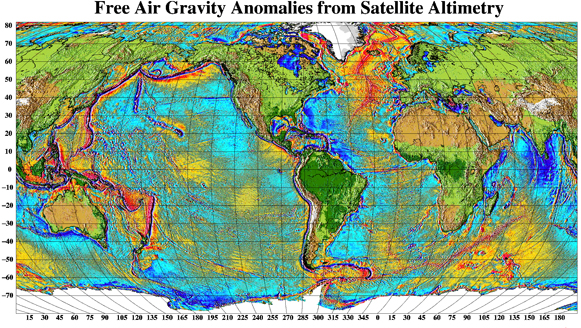A new map of the gravitational forces on the Earth based on satellite data makes it easier to find new oil deposits especially in the Arctic regions affected by global warming

The American company Fugro, one of the world's leading companies in the search for oil deposits, initiated a research collaboration with the National Space Institute at the Technical University of Denmark to search for oil deposits by mapping Gravitational forces of the areas studied with the help of satellites. According to the company, a gravity map of the surface is one of the most accurate methods and has the widest coverage nowadays, all thanks to the high resolution and accuracy of the map.
Changes in gravity on the Earth's surface and a thorough knowledge of the effect of these tiny changes is a valuable tool in the field of oil exploration. Underground oil deposits are sealed by relatively light material such as limestone and clay, and because these materials are light they have less gravity than other materials in the given area. use ofsatellite data Up-to-date made it possible to compile a high-resolution gravity map that has never been seen before in terms of its detail and the accuracy of the information. From here, the path to finding new oil deposits that have not yet been discovered is extremely short.
The oil search process consists of several stages, the use of the gravity map allows companies to increase the likelihood of finding oil in the first and most critical stage - choosing a location. In the past, oil companies would select "interesting" areas with the help of assessments based on data obtained from pilot vessels and vessels, collecting the information was expensive and the accuracy of the data was not always high. Whereas today, the use of the gravity map saves many costs already in the first stage and directs the companies to the areas with the highest probability of finding oil. This way the company saves costs and optimizes work processes.
The gravity map of the Technical University of Denmark is quite unique because of its high resolution of only 2 km and because it covers both land and oceans. The map is especially useful in coastal areas, where most of the oil deposits are located.
The map is also useful in the frozen arctic. The melting process of the glaciers reveals wide areas of sea, where there is great potential for underground oil reserves that have not yet been discovered. Using gravity data allows to start the process of drilling processes in the right place much faster.
Most of the success of the gravity map can be attributed to the fact that it is not based on the measurement of gravity directly but on observations of sea level, the reflectors of gravity. The height measurement has the advantage that the measurement makes it possible to determine the regional gravitational field and thus the gravity map reduces the resolution to only a few kilometers. For comparison, when a satellite measures the gravitational forces, the resulting resolution is usually around 200 km. Gravity data from satellites are used, for example, to analyze conditions in the deep layers of the Earth, but they are not suitable for the needs of oil companies.

8 תגובות
Why is there ownership of things?
Why does whoever buys land, it is his?
Lee, now that you say it, it's fair enough. One hundred million will get 50%, and the one who found 50% is equal.
Yes, it's called taxes.
To me, there is a huge margin between "the oil does not belong to you at all" and "all your oil".
To the point, because otherwise no one would look for it, and invest in order to pump it.
The big question is why does the oil belong to whoever finds it or extracts it?
Where is the color key for the map?